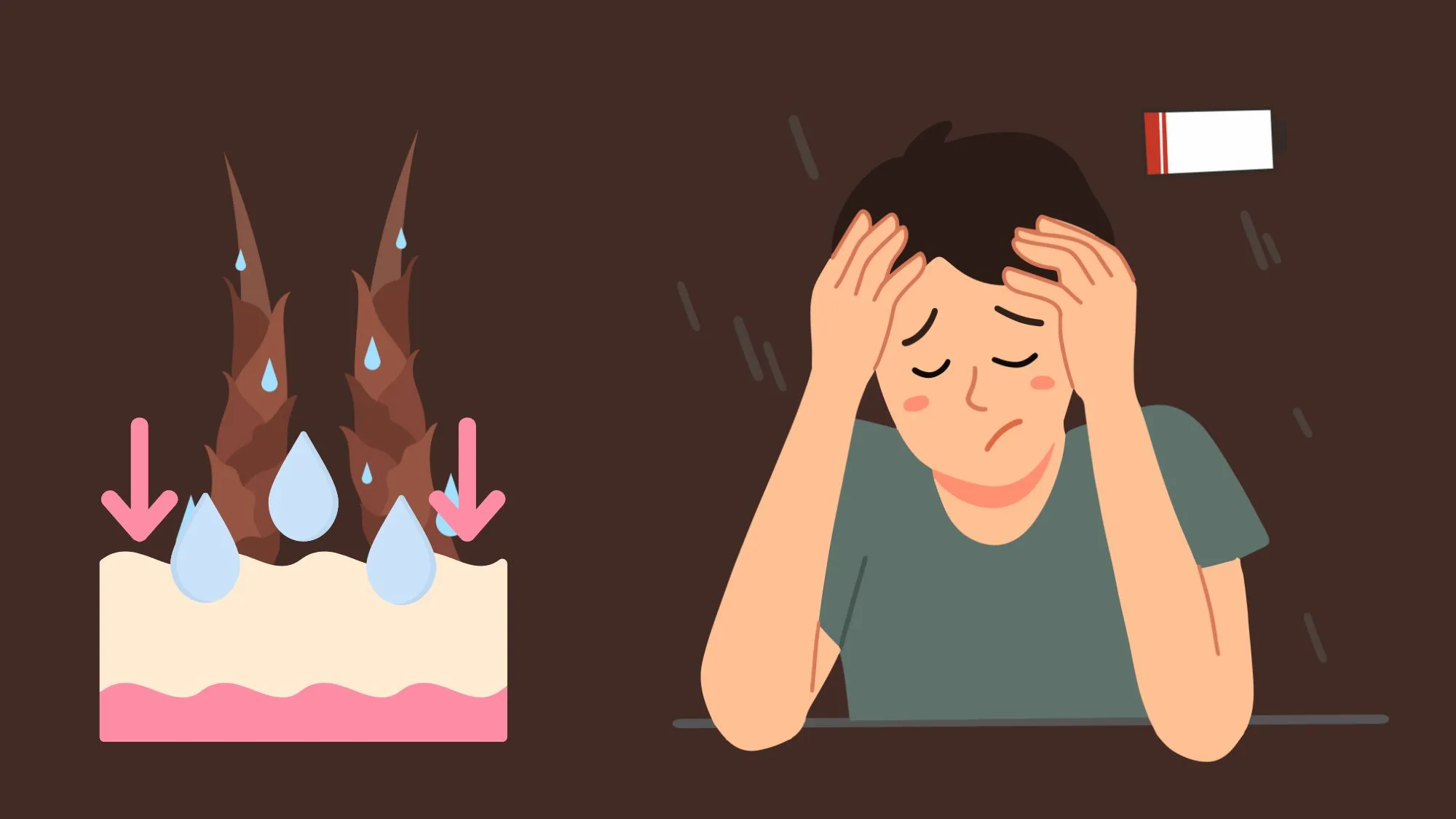
If you have low porosity hair, you may have experienced difficulty in finding the right products to keep your locks moisturized and healthy. Fortunately, using the right oils can be a game-changer for managing low porosity hair. In this article, we will explore the characteristics of low porosity hair, how to determine your hair porosity, the importance of choosing the right oil, and the top oils that work wonders for low porosity hair. We will also discuss how to properly apply oils to your hair and common mistakes to avoid.[1]
Understanding Low Porosity Hair
Before we delve into the best oils for low porosity hair, it’s important to understand what low porosity hair actually means. Low porosity hair refers to hair that has tightly closed cuticles, which makes it difficult for moisture to penetrate. As a result, low porosity hair tends to be more prone to dryness and can easily become weighed down by heavy products.
Low porosity hair is a unique hair type that requires special care and attention. The tightly closed cuticles create a barrier that prevents moisture from entering the hair shaft. This can lead to a lack of hydration, making the hair feel dry and brittle. It also means that low porosity hair has a harder time absorbing and retaining moisture, which can result in product buildup and a lack of volume.
However, low porosity hair also has its advantages. The tightly closed cuticles make it less prone to damage from external factors such as heat and chemical treatments. It also tends to have a natural shine and can hold styles well.
Characteristics of Low Porosity Hair
There are a few key characteristics that can help you determine if you have low porosity hair. Firstly, low porosity hair takes longer to dry and may resist water absorption. If you notice that water beads up on your hair instead of being absorbed, chances are you have low porosity hair. This can be frustrating when trying to style your hair or when you’re in a rush and need your hair to dry quickly.
Additionally, low porosity hair may feel coarse or rough to the touch. The tightly closed cuticles give the hair a rough texture, which can make it more difficult to detangle and style. It’s important to use the right products and techniques to keep your low porosity hair soft and manageable.
Another characteristic of low porosity hair is its tendency to experience product buildup. Since the cuticles are tightly closed, it’s harder for products to penetrate the hair shaft. This can result in a buildup of products on the surface of the hair, making it look dull and lifeless. Regular clarifying treatments are essential for maintaining the health and appearance of low porosity hair.
How to Determine Your Hair Porosity
To determine your hair porosity, you can try the porosity test. Take a strand of clean hair and drop it into a glass of water. If the hair floats on the surface for a long time, it indicates low porosity. This means that your hair has a hard time absorbing moisture and may require extra care to keep it hydrated. On the other hand, if the hair sinks immediately, it indicates high porosity. This means that your hair easily absorbs moisture but may also lose it quickly. If the hair sinks after a few minutes, it indicates normal porosity. This means that your hair has a good balance of moisture absorption and retention.
Knowing your hair porosity can help you choose the right products and techniques for your hair type. For low porosity hair, lightweight and water-based products are recommended to prevent product buildup and allow for better moisture absorption. Deep conditioning treatments and steam treatments can also help open up the cuticles and improve moisture penetration.
The Importance of Choosing the Right Oil
When it comes to low porosity hair, choosing the right oil is crucial for maintaining moisture balance and keeping your hair healthy. Oils help to seal moisture into the hair shaft and prevent moisture loss, making them an essential part of any hair care routine.
Low porosity hair has tightly closed cuticles, which means that it is more resistant to moisture absorption. This can lead to dryness and brittleness if not properly cared for. However, with the right oil, you can enhance the health and appearance of your low porosity hair.
The Role of Oil in Hair Care
Oils act as a protective barrier for the hair, preventing damage from external factors such as heat and pollution. They create a shield around the hair shaft, reducing the risk of breakage and keeping your locks strong and resilient. Additionally, oils help to lubricate the hair, making it easier to detangle and style.
But the benefits of oil don’t stop there. Oils can also nourish the scalp, promoting a healthy environment for hair growth. They can stimulate blood circulation, which in turn encourages the hair follicles to produce new strands. So, if you’re looking to boost your hair growth, incorporating the right oil into your routine is key.
Furthermore, oils can add a beautiful shine to your low porosity hair. They smooth down the cuticles, reflecting light and giving your locks a glossy and lustrous appearance. Say goodbye to dull and lifeless hair, and hello to radiant and healthy-looking locks!
Factors to Consider When Choosing Hair Oil
When selecting an oil for low porosity hair, it’s important to consider a few factors. Firstly, choose oils that are lightweight and easily absorbed by the hair. Heavy oils can weigh down low porosity hair and make it appear greasy. Look for oils that have a thin consistency, as they are more likely to penetrate the tightly closed cuticles of low porosity hair.
Moisturizing properties are also crucial when choosing the right oil. Low porosity hair needs moisture to thrive, so opt for oils that have hydrating properties. These oils will help to replenish the moisture that your hair craves, leaving it soft, supple, and well-nourished.
Lastly, consider the nutrient content of the oil. Look for oils that are rich in vitamins, minerals, and antioxidants. These nutrients can provide your hair with the essential building blocks it needs to grow and thrive. They can also help to strengthen the hair shaft, reducing the risk of breakage and promoting overall hair health.
So, the next time you’re in search of the perfect oil for your low porosity hair, keep these factors in mind. Choose an oil that is lightweight, moisturizing, and packed with nutrients. With the right oil, you can unlock the full potential of your low porosity hair and achieve the healthy and beautiful locks you’ve always dreamed of.[2][3]
Top Oils for Low Porosity Hair
Now that you understand the importance of choosing the right oil, let’s explore some of the top oils that work wonders for low porosity hair.
Benefits of Jojoba Oil
Jojoba oil is often hailed as a holy grail for low porosity hair. It closely resembles the natural sebum produced by our scalp, making it easily absorbed by the hair. This incredible oil is derived from the seeds of the jojoba plant, which is native to the arid regions of the southwestern United States and northern Mexico.
Jojoba oil is not only lightweight and non-greasy, but it also helps to moisturize and condition the hair without weighing it down. It is packed with essential nutrients like vitamin E, B vitamins, and minerals such as zinc and copper. These nutrients work together to nourish and strengthen the hair, promoting overall hair health.
Additionally, jojoba oil has anti-inflammatory properties that can soothe the scalp and promote hair growth. It can help to reduce scalp irritation, itching, and dandruff. The oil’s moisturizing properties also prevent the scalp from becoming dry and flaky, creating a healthy environment for hair growth.
Top 3 Best Jojoba Oils for Hair
-
Cliganic Organic Jojoba Oil.
Proudly USDA organic certified, guaranteeing the highest quality and integrity. It’s 100% pure, made from a single ingredient with no synthetic additives. This multipurpose oil offers the best benefits for the face, hair, and body, with remarkable effects on the skin, scalp, beard, and hair suitable for all skin types. The Jojoba Carrier Oil is lightweight, unrefined, and fast-absorbing, making it gentle enough for even the most sensitive skin. It is also non-GMO certified, vegan, and cruelty-free, free from additives. Cliganic’s organic jojoba oil is sustainably sourced and minimally processed, ensuring a product that aligns with ethical and environmental values.
-
NOW Solutions – Organic Jojoba Oil.
This multi-purpose certified organic body oil by Now Solutions is 100% pure and derived from the jojoba shrub’s seed. It’s a popular cosmetic oil known for its high quality, obtained through expeller pressing without hexane or parabens, and it’s vegan. Suitable for skin, hair, and body, this non-GMO project-verified oil is widely used for its stability, refreshing scent, and versatility, promoting softer hair and skin for all types. Now Solutions represents the next step in personal care evolution, crafted with the finest functional ingredients from around the world. The product meets GMP quality standards with NPA A-rated GMP certification, ensuring rigorous examination of every aspect of the manufacturing process, including laboratory testing for stability, potency, and formulation.
 NOW Solutions – Organic Jojoba Oil
NOW Solutions – Organic Jojoba Oil
-
Handcraft Blends Organic Jojoba Oil.
Cold-pressed from jojoba seeds, making it ideal for aromatherapy, massage, and as a natural moisturizer for hair and skin. This premium-quality, hexane-free, preservative-free, and 100% vegan jojoba oil absorbs easily, soothing and softening the skin while promoting a healthy glow. It’s a fantastic moisturizer for dry skin, nourishing both skin and hair and encouraging healthy growth. Packed with natural vitamins, antioxidants, and anti-aging properties, it helps reduce wrinkles, fine lines, and dark spots and promotes softer, younger-looking skin. Additionally, it serves as an excellent carrier oil for diluting essential oils, enhancing their effectiveness in massage and skincare routines.
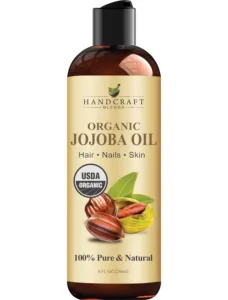 Handcraft Blends Organic Jojoba Oil
Handcraft Blends Organic Jojoba Oil
Why Argan Oil Works Well
Argan oil, also known as “liquid gold.” It is another fantastic option for low porosity hair. It is derived from the kernels of the argan tree, which is native to Morocco. For centuries, Moroccan women have used argan oil for its incredible benefits on both hair and skin.
What makes argan oil so special? It is rich in essential fatty acids, antioxidants, and vitamins, which help to nourish and strengthen the hair. These nutrients penetrate the hair shaft, repairing any damage and restoring its natural shine and luster. Argan oil is easily absorbed by the hair, leaving it soft, shiny, and manageable.
In addition to its moisturizing properties, argan oil also helps to tame frizz and reduce flyaways, making it a versatile option for styling low-porosity hair. It creates a protective barrier around the hair shaft, preventing moisture loss and environmental damage. This makes argan oil an excellent choice for those with low porosity hair who want to maintain moisture balance and protect their hair from external stressors.
Top 3 Best Argan Oils for Hair
-
Arvazallia Hydrating Argan Oil.
Hydrates and softens dry, damaged hair, improving manageability. Repairs and restores overprocessed hair, enhancing texture, elasticity, and shine. Infused with nourishing argan oil, it provides essential vitamins. Sulfate-free, paraben-free, suitable for all hair types, including permed, natural, and curly.
 Arvazallia Hydrating Argan Oil
Arvazallia Hydrating Argan Oil
-
OGX Renewing Argan Oil.
Revitalize your hair with OGX Renewing + Argan Oil of Morocco Hair Oil Treatment. Suitable for all hair types, this 3.3-ounce treatment seals in nutrients, leaving hair strong, silky, and radiant. Inspired by nature, it features cold-pressed Moroccan argan oil for a natural boost and a delightful scent. Free from parabens and sulfates, this non-harsh, nourishing formula improves strength and elasticity for soft, touchable tresses.
-
Moroccanoil Treatment.
A multitasking hair treatment enriched with antioxidant-rich argan oil and essential fatty acids for a healthier look and feel. Rated as the #1 haircare oil in the US.
The Magic of Grapeseed Oil
Grapeseed oil is a lightweight oil that is quickly absorbed by low porosity hair. It is derived from the seeds of grapes, which are a byproduct of winemaking. Grapeseed oil has been used for centuries in traditional medicine and skincare due to its numerous benefits.
One of the key advantages of grapeseed oil is its moisturizing properties. It helps to moisturize the hair without leaving a greasy residue, making it perfect for low porosity hair. Grapeseed oil is rich in antioxidants and vitamin E, which promote healthy hair growth and protect the hair from environmental damage.
Furthermore, grapeseed oil has a high concentration of linoleic acid, an essential fatty acid that moisturizes and strengthens the hair. It helps to seal the hair cuticles, preventing moisture loss and reducing frizz. This makes grapeseed oil an excellent choice for low porosity hair, as it provides the necessary hydration without weighing the hair down.
Top 3 Best Grapeseed Oils for Hair
-
NOW Solutions Grapeseed Oil.
NOW 100% Pure Grapeseed Oil is a gentle, odorless option for sensitive skin care, featuring essential fatty acids. Its silky texture soothes dryness without clogging pores, suitable for all skin types. Ideal as a lotion base and a mild hair conditioner for all hair types. GMP Quality Assured with NPA A-rated GMP certification, ensuring thorough examination of the manufacturing process. Packaged in the USA by a family-owned company since 1968.
-
Handcraft Grapeseed Oil.
Versatile for aromatherapy, massage, and as a fragrance-free hair and skin moisturizer. Cold-pressed with a light texture, it easily absorbs, dislodges debris from pores, and protects against UV damage. Rich in vitamins A, E, and K, it’s a common ingredient in cosmetics like sunscreen and moisturizers. Ideal for diluting essential oils, it’s hexane-free, preservative-free, and cruelty-free. Imported from Chile, our premium oil is bottled in an approved facility, free from alcohol, parabens, and sulfates.
-
PURA D’OR Organic Grapeseed Oil.
Conditions, smooths frizz, and flyaways, detangles, and enhances shine by up to 118%.
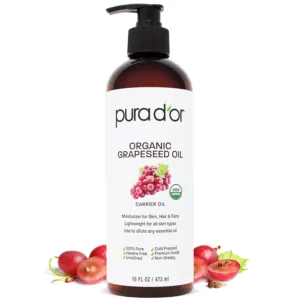 PURA D’OR Organic Grapeseed Oil
PURA D’OR Organic Grapeseed Oil
Jojoba oil, argan oil, and grapeseed oil are all fantastic options for those with low porosity hair. Each oil offers unique benefits, from mimicking the scalp’s natural sebum to providing essential nutrients and protecting the hair from damage. Incorporating these oils into your hair care routine can help you achieve healthy, moisturized, and beautiful low porosity hair.[4][5][6]
How to Apply Oils to Low Porosity Hair
Now that you have chosen the right oil for your low porosity hair, it’s important to know how to properly apply it to maximize its benefits.
Pre-Poo Treatment
A pre-poo treatment involves applying oil to your hair before shampooing. To protect it from the drying effects of shampoo. Before washing your hair, divide it into sections. Apply the oil from root to tip. Leave the oil on for at least 30 minutes or overnight for deeper moisturization. This step helps to soften and detangle the hair. Making it easier to manage during the washing process.
Deep Conditioning with Oils
Deep conditioning with oils is a great way to nourish and hydrate low porosity hair. After shampooing, apply a generous amount of oil to damp hair, focusing on the ends and dry areas. Cover your hair with a shower cap or towel and leave the oil on for about 30 minutes. The heat from your scalp will help the oil penetrate the hair shaft. Rinse out the oil thoroughly and follow with a conditioner to lock in moisture.
Sealing in Moisture with Oils
After washing and conditioning your hair, sealing in moisture with oils is essential for keeping your low porosity hair hydrated throughout the day. Apply a small amount of oil to your fingertips and gently distribute it through the ends of your hair, focusing on any dry or damaged areas. Avoid applying too much oil to the roots to prevent a greasy appearance. This step helps to lock in moisture and prevent moisture loss throughout the day.
Common Mistakes to Avoid
While oils can work wonders for low porosity hair, it’s important to avoid common mistakes that can lead to less-than-desirable results.
Overuse of Oils
Using too much oil on your low porosity hair can leave it feeling greasy and weighed down. Start with a small amount and gradually increase if needed. Remember, a little goes a long way when it comes to oils for low porosity hair.
Using Oils That Are Too Heavy
Low porosity hair does not require heavy oils that may sit on the surface and make your hair appear greasy. Opt for lightweight oils that can easily penetrate your hair shaft and provide hydration without weighing it down.
Not Applying Oils to Damp Hair
For optimal absorption, it’s important to apply oils to damp hair. The water on your hair helps to open up the cuticles and allows the oil to penetrate more effectively. Make sure to pat your hair dry with a towel before applying the oil.
Using the right oils is essential for caring for low porosity hair. Jojoba oil, argan oil, and grapeseed oil are all excellent choices for moisturizing and nourishing low porosity hair. Remember to properly apply the oils through pre-poo treatments, deep conditioning, and sealing in moisture. Also, avoid common mistakes such as overusing oils or using ones that are too heavy. With the right oils and proper care, you can keep your low porosity hair healthy, hydrated, and gorgeous.
Use CareClinic App to Track Your Hair Care Routine
Managing low porosity hair requires consistent care and attention to detail. With the CareClinic App, you can effortlessly track your hair care routine, monitor the effects of different oils on your hair’s health, and adjust your regimen for optimal results. CareClinic’s diary feature allows you to record your pre-poo treatments, deep conditioning sessions, and daily oil applications, helping you identify what works best for your unique hair type. Set reminders for your hair care routine. Track your progress over time to see the improvements in your hair’s moisture and overall health. By using the CareClinic App, you can take control of your hair care journey and ensure that your low porosity hair remains hydrated and vibrant. Ready to enhance your hair care experience? Install the CareClinic App today and start seeing the benefits for your low porosity hair.[7]
References
- “Best Oils for Low Porosity Hair | The Derm Spot”. https://thedermspot.com/oils-for-low-porosity-hair/
- “Top 8 Best Oils for Low Porosity Hair – San Diego Health”. https://sandiegohealth.org/top-8-best-oils-for-low-porosity-hair/
- “Hydration Without Buildup: Best Oils for Low Porosity Hair”. https://www.beautyinsightshub.com/the-best-oils-for-low-porosity-hair/
- “Is Jojoba Oil Good For Low Porosity Hair? – Curls and Cocoa”. https://curlsandcocoa.com/jojoba-oil-low-porosity-hair/
- “Argan Oil For Low-Porosity Hair Care: Expert Tips”. https://arganoilshop.com/blog/low-porosity-hair-care/
- “ᐅ 9 Best Oils for Low Porosity Hair – Moisturizing & Nourishing”. https://www.lippiehippie.com/hair-porosity/low/oils/
- “Unlock the Secret: Oils for Low Porosity Hair – Nifty Wellness”. https://niftywellness.com/oils-for-low-porosity-hair/


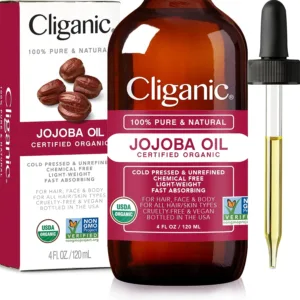 Cliganic Jojoba Oil
Cliganic Jojoba Oil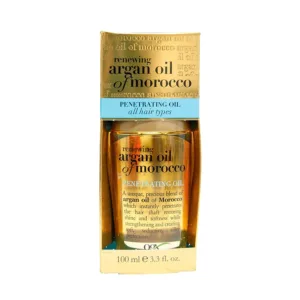 OGX Renewing Argan Oil
OGX Renewing Argan Oil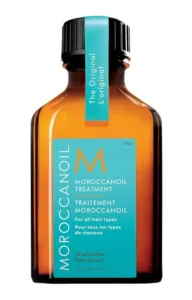 Moroccanoil Treatment
Moroccanoil Treatment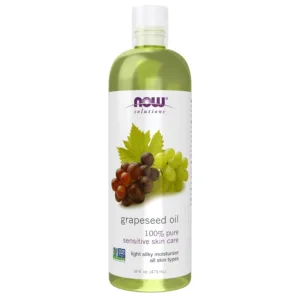 NOW Solutions Grapeseed Oil
NOW Solutions Grapeseed Oil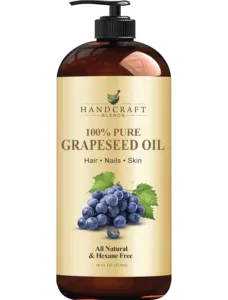 Handcraft Grapeseed Oil
Handcraft Grapeseed Oil